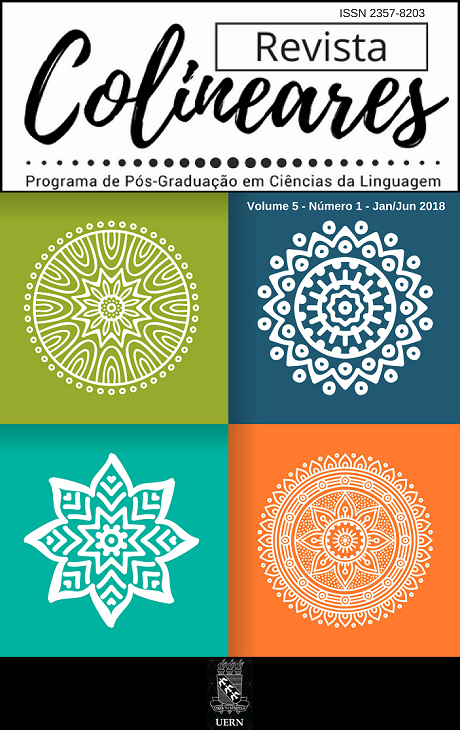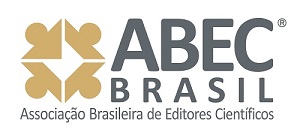OS TERMOS "˜INTERFERÊNCIA"™ E "˜TRANSFERÊNCIA LINGUÍSTICA"™ NA ÁREA DE AQUISIÇÃO DE LÍNGUAS ADICIONAIS: UMA DISCUSSÃO SOBRE SUAS DIFERENTES ACEPÇÕES
Mots-clés :
Transferência linguística, Sistemas Adaptativos Complexos, Influência translinguísticaRésumé
O presente artigo visa a discutir os termos 'interferência' e 'transferência interlinguística', bem como promover um perpassar histórico acerca do desenvolvimento da definição teórica de transferência linguística, desde Weinreich (1953) e Lado (1957) até alcançar a noção de influência sob a perspectiva de língua como Sistema Adaptativo Complexo (RINGBOM, 1985; CENOZ, 2001; HERDINA; JESSNER, 2002; JESSNER, 2008; BRITO, 2011). O termo "˜interferência"™ foi rejeitado (GASS; SELINKER, 1992; CORDER, 1992; ORTEGA, 2009), por indicar um sentido negativo de intervenção da língua materna no desenvolvimento de uma dada "˜língua-alvo"™. Já sob uma concepção de língua como Sistema Adaptativo Complexo, o termo "˜transferência"™ é frequentemente chamado de "˜influência interlinguística"™, sendo visto como um fenômeno que exerce efeitos de uma língua na outra, a partir da possibilidade de múltiplas relações entre os subsistemas envolvidos (L1, L2 e L3), sendo considerado um fator característico do próprio sistema multilíngue (RINGBOM, 1985; CENOZ, 2001; HERDINA; JESSNER, 2002; KUPSKE, 2016; PEREYRON, 2017; de LOS SANTOS, 2018). Ademais, serão discutidos, sob a perspectiva teórica aqui adotada, fatores como a tipologia linguística e proficiência linguística como agentes condicionadores de influência. Finalmente, ao tomar como foco, mais especificamente, o processo de desenvolvimento do componente fonético-fonológico, o presente artigo oferece uma proposta quanto ao termo "˜transferência"™ com base em LarsenFreeman (2015), quem assegura envolver muito mais do que o mero fenômeno de transferir elementos no desenvolvimento linguístico de um aprendiz, a autora afirma que o processo envolve criatividade, inovação, recombinação.
Téléchargements
Références
BECKNER, C.; BLYTHE, R.; BYBEE, J.; CHRISTIANSEN, M.; CROFT, W.; ELLIS, N.; HOLLAND, J.; KE, J.; LARSEN-FREEMAN, D.; SCHOENEMANN, T. Language is a Complex Adaptive System: Position Paper. Language Learning, v. 59, n. 1, 2009. p. 1-26.
BEST, K.; TYLER, M. D. Nonnative and second-language speech perception: Commonalities and complementarities. In: MUNRO, M. J.; BOHN, O. S. (Eds.). Second language speech learning: The role of language experience in speech perception and production. Amsterdam: John Benjamins Publishing Company, 2007. p. 13-34.
BIALYSTOK, E.; BARAC, R. Cognitive affects. In: GROSJEAN, F. & LI, P. The psycholinguistics of Bilingualism. Hoboken: Wiley, 2013. p. 192-213.
BLANK, C.A. A transferência grafo-fônico-fonológica L2 (francês) – L3 (inglês): um estudo conexionista. Dissertação (Mestrado em Letras). Pelotas: Universidade Católica de Pelotas. 2008.
______. A influência grafo-fônico-fonológica na produção oral e no processamento de priming em multilíngues: uma perspectiva dinâmica. Tese (Doutorado em Letras). Universidade Católica de Pelotas, Pelotas. 2013.
BLOOMFIELD, L. Language. New York: Holt, Rinehart, and Wintson, 1945.
BRITO, K. S. Influências interlinguísticas na mente multilíngue: Perspectivas psicolinguísticas e (psico)tipológicas. Tese (Doutorado em Letras). Curitiba: Universidade Federal do Paraná. 2011.
CENOZ, J. The Effect of Linguistic Distance, L2 Status and Age on Cross-linguistic Influence in Third Language Acquisition. In: CENOZ, J.; HUFEISEN, B.; JESSNER, U. Cross-linguistic Influence in Third Language Acquisition: Psycholinguistic Perspectives. Multilingual Matters. Bristol: Multilingual matters, 2001. p. 8-20.
DE BOT, K. The Multilingual Lexicon: Modelling Selection and Control. International Journal of Multilingualism, v.1, n. 1, 2004, p. 17-32.
______. Complexity Theory and Dynamic Systems Theory: Same or different? In: ORTEGA, L.; HAN, Z. (eds.) Complexity Theory and Language Development. Amsterdam: John Benjamins Publishing Company, 2017. p. 51-58.
DE BOT, K.; LOWIE, W.; VERSPOOR, M. (2007) A Dynamic System Theory approach to second language acquisition. Bilingualism: Language and Cognition, v. 10, n. 1, p. 7-21.
DE LOS SANTOS, B. R. A produção da vogal átona final /e/ por porto-algrenses aprendizes de espanhol como segunda língua (LA): uma investigação sobre atrito linguístico em ambiente de LA não-dominante. Dissertação (Mestrado em Letras) Porto Alegre, Universidade Federal do Rio Grande do Sul. 2017.
DEWAELE, J-M. Lexical inventions: French interlanguage as L2 versus L3. Applied Linguistics, v. 19, n. 4,1998, p. 471-490.
ELLIS, N. The Emergence of Language as a Complex Adaptive System. In: SIMPSON, J. (ed.). Routledge Handbook of Applied Linguistics. Amsterdam: Abingdon: Routledge/Taylor Francis, 2011. p. 654-667.
FLEGE, J. E. Second Language Speech Learning: Theory, Findings, and Problems. In: STRANGE, W. (ed.) Speech perception and linguistic experience: issues in cross language research. Timonium, MD: York press, 1995.
FRANCESCHINI, R. Sprachadoption: der Einfluss von Minderheitensprachen auf die Mehrheit, oder: Welche Kompetenzen der Minderheitensprachen haben Minderheitensprachen? Bulletin Suisse de Linguistique Appliquée, v. 69, n. 2. 1999.
FRIES, C. Teaching and Learning English as Foreign Language. Ann Arbor: University of Michigan press, 1945.
GALLARDO DEL PUERTO, F. Is L3 Phonological Competence Affected by the Learner"™s Level of Bilingualism? International Journal of Multilingualism, v. 4, n. 1, 2007, p. 1-16.
GASS, S. M.; SELINKER, L. Introduction. In: GASS, S. M.; SELINKER, L. (eds). Language Transfer in Language Learning. Amsterdam: John Benjamins B. V., 1992.
GREEN, D. W. Control, activation, and resource: A framework and a model for the control of speech in bilinguals. Brain and Language, v. 27, n. 2, 1986/1998, p. 210- 223.
GROJEAN, F. (2013) Introduction. In: GROSJEAN, F. & LI, P. The psycholinguistics of Bilingualism. Hoboken: Wiley-Blackwell, 2013.
______; LI, P. (2013). The psycholinguistics of Bilingualism. Hoboken: WileyBlackwell, 2013.
______; PY; B. La restructuration d"™une première langue: l"™intégration de variants de contact dans la competence de migrants bilingues. La Linguistique, v. 23, 1991, p. 35-60.
HAMMARBERG, B. Roles of L1 and L2 in L3 production and acquisition. In: CENOZ, J; HUFEISEN, B; JESSNER, U. (eds.) Cross-linguistic Influence in Third Language Acquisition: Psycholinguistic Perspectives. Bristol: Multilingual matters, 2001. p. 21-41.
HERDINA, P.; JESSNER, U. A Dynamical Model of Multilingualism: Perspectives of Change in Psycholinguistics. Bristol: Cromwell Press Ltd., 2002.
JESSNER, U. Teaching third languages: Findings, trends and challenges. Language Teaching, v. 41, n. 1, 2008. p. 15-58.
KUPSKE, F. F.. Imigração, atrito e complexidade: a produção das oclusivas iniciais surdas do inglês e do português por sul-brasileiros residentes em Londres. Tese (Doutorado em Letras), Porto Alegre: Universidade Federal do Rio Grande do Sul. 2016.
LADO, R. Linguistics across cultures: applied linguistics for languages teachers. Michigan: University of Michigan Press, 1957.
LARSEN-FREEMAN, D. Chaos/Complexity Science and Second Language Acquisition. Applied Linguistics, v.18, n. 2, 1997, p. 141-165.
______. Complex, dynamics systems: A new transdisciplinary theme for applied linguistics? Language Teaching, v. 45, n. 2, 2011, p. 1-13.
______. Complexity Theory. In: VANPATTEN, B.; WILLIAMS, J. (eds).Theories in Second Language Acquisition: An introduction. Amsterdam: Routledge/Taylor Francis, 2015. p. 227-244.
LENNERBERG, E. Biological Foundations of Language. New York: Wiley, 1967.
MERCER, S. Understanding learner agency as a complex dynamic system. System, v. 39, 2011, p. 427-436.
ODLIN, T. Language Transfer: cross-linguistic influence in language learning. Cambridge: Cambridge University Press, 1989.
OLSEN, S. Errors and compensatory strategies: A study of grammar and vocabulary in texts written by Norwegian learners of English. System, v. 27, n. 2, 1999, p. 191- 200.
ORTEGA, L. Understanding Second Language Acquisition. Oxford: Hachette UH Company, 2009.
PENFIELD, W.; ROBERTS, L. Speech and Brain Mechanisms. Princeton: Princeton University Press, 1959.
PENFIELD, W. Conditioning the uncommited cortex for language learning. Brain. Oxford: Oxford University Press, 1965. p. 787-798.
PEREYRON, L. A produção vocálica por falantes de espanhol (L1), inglês (L2) e português (L3): uma perspectiva dinâmica na (multi) direcionalidade da transferência linguística. Tese (Doutorado em Letras). Porto Alegre, Universidade Federal do Rio Grande do Sul, 2017.
RICHARDS, J. C. (1970) A Non-Contrastive Approach to Error Analysis. ELT journal, v. 25, n. 3, 1970, p. 204-219.
RINGBOM, H. The Influence of Swedish on the English of Finnish Learners, Eric, 1985, p. 39-71.
ROSSI, S. (2006) L´interference lexicale dans l´acquisition d´une troisieme langue: effetlangue seconde ou distance typologique? Dissertação (Mestrado em Letras). Galgary, University of Galgary, 2006.
SELINKER, L. Interlanguage. International Review of Applied Linguistics, v.10, n.3, 1972, p. 209-231.
SCHERESCHEWSKY, L. C.; ALVES, U. K.; KUPSKE, F.F. First language attrition: the effects of English (L2) on Brazilian Portuguese Vot patterns in an L1-dominant environment. Letrônica, v.10, n. 2, 2017, p. 700-716.
SCHERESCHESKY, L. C. O atrito linguístico sobre os padrões de VOT do português: efeitos do inglês (L2) e do alemão (L3) em aprendizes bilíngues e trilíngues. Trabalho de Conclusão de Curso (Letras). Porto Alegre: Universidade Federal do Rio Grande do Sul, 2018.
VAN HELL, J.G.; TANNER, D. Second Language Proficiency and Cross-Language Lexical Activation. Language Learning, v.62, 2012, p. 148-171.
VANPATTEN, B. What is second language acquisition and what is doing in this department? ADFLBulletin, v. 30, n. 30, 1999, p. 49-53.
WALTER, C. (2007) First- to second-language reading comprehension: Not transfer, but access. International Journal of Applied Linguistics, v. 17, n.1, 2007, p. 14-37.
WEINREICH, U. Languages in Contact. The Hague: Mouton, 1953/1964. WUNDER, E.M. Phonological Cross-linguistic Influence in Third or Additional Language Acquisition. 6th New Sounds, 2010.
Téléchargements
Publiée
Comment citer
Numéro
Rubrique
Licence
© Letícia Pereyron 2018

Ce travail est disponible sous licence Creative Commons Attribution - Pas d’Utilisation Commerciale - Partage dans les Mêmes Conditions 4.0 International.






